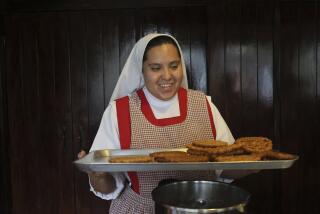Virgin of Guadalupe Is in Fashion, to Many of the Faithful’s Dismay
- Share via
For nearly five centuries, believers in the Virgin of Guadalupe have celebrated the anniversary of her appearance before a poor Indian on Dec. 12, 1531.
As thousands of Catholics in Southern California celebrate her feast day today, the Virgin is more likely to be seen on water bottles, belt buckles and prepaid phone cards.
A beacon of hope for the downtrodden, a legendary figure who has long bonded Mexicans to the Catholic Church, the patron saint of Mexico and the Americas has also emerged in the last decade as a lucrative pop culture icon, much like Mexican artist Frida Kahlo, Argentine revolutionary Che Guevara -- and even Mickey Mouse.
Her image adorns blankets made in China that sell for $30 in Santa Ana markets. Guadalupe belt buckles go for $250 in Sherman Oaks’ Belle Gray boutique.
The brown-skinned beauty -- traditionally shown with open arms and a flowing, colorful robe -- is no longer strictly a religious figure, some say.
The Virgin “has stepped off the altar, outside the confines of the church. She is a transcultural goddess,” said Jacqueline Orsini Dunnington, author of the new book “Celebrating Guadalupe.”
But the Virgin’s popularity in nonspiritual settings has rankled some devout Catholics, who say her adoration should not be sullied by commercialism.
“The symbol should come with Catholic values. When it doesn’t, we are being taken advantage of,” said Father Jose Luis Morras-Etayo of Our Lady of Guadalupe Sanctuary in Los Angeles -- one of 10 parishes in the archdiocese bearing her name.
For Latinos who identify with her, the Virgin of Guadalupe -- a New World manifestation of the Virgin Mary -- is more than a religious symbol, said Nancy Pineda-Madrid, an assistant professor of religious studies at St. Mary’s College in Moraga. At the time of her appearance, Europeans were colonizing Mexico and oppressing its indigenous people.
“She stands for the inception of the Mexican nation, the emergence of the mestizo people,” she said.
Much of Mexico’s history is wrapped in her image.
According to believers, the Virgin first appeared to Juan Diego on Dec. 9, 1531, on a rocky hill outside Mexico City. Speaking to Diego in his native Nahuatl language, she asked him to go to the bishop and have him build a church. When he told the bishop of the apparition, the cleric didn’t believe the story.
When the Virgin appeared to Diego on Dec. 12, she gave him roses to take as evidence. In front of the bishop, Diego opened his cloak to find her image on it.
A reproduction of that cloak drew more than 7,000 people, organizers say, to a recent event at East Los Angeles College sponsored by Las Guadalupanas, an organization that promotes the devotion of Guadalupe within the Archdiocese of Los Angeles.
Today, thousands in Southern California will celebrate her feast day with Masses, processions and rosaries, similar to those held in Mexico, where Dec. 12 is a national holiday. Our Lady of Guadalupe Sanctuary in Los Angeles will have 11 Masses in her honor.
That same fervor draws many customers for those who sell that image in more unlikely set- tings.
While at El Mercadito in East Los Angeles recently, Marisela Noriega, who was raised Catholic in Mexico, bought a wooden box with the Virgin’s image.
“It’s a Christmas present, for me,” said the 34-year-old, who recently lost her job as a baby-sitter. “It’s to remind me of what she does for me, of the faith I have, no matter what the hardships I face.”
Orsini Dunnington said she has found the Virgin’s image on violins, cowboy boots, grocery store walls, salsa bottles and hairspray cans.
The Virgin means hope to so many, she said, “and that is why you can see her everywhere, from the littlest trinket to the most elaborate churches.”
Indeed, products incorporating the Virgin of Guadalupe are estimated to generate $1 billion in sales annually in the United States, said Marshal Cohen, chief analyst for New York-based NPD Group, a company that studies retail trends.
“This is a market that has really grown over the last 10 years.”
She’s become “like Mickey Mouse. It’s become very popular. People just like it. They give it their own meaning,” said Jesse Mancillas, a manager at Tesoros Trading Co. in Austin, Texas, which stocks items with the Virgin’s image.
This commercial profusion irritates some.
Father Paul Sustayta of the Holy Spirit Church in Los Angeles says the Virgin should not be a marketing gimmick.
“There are Catholics who buy these items in faith. Others, who are not Catholic, are just selling these images because they are the latest thing,” he said. “They are using that image to make a buck.”
Even some skeptics, however, find themselves tempted.
Alma Nieto said she hopes to see the original cloak at the Basilica de Nuestra Senora de Guadalupe in Mexico City. She calls the commercialism “outrageous.”
“It loses the message. It blurs what it all really means when you see it on a phone card,” she said.
But when the receptionist of La Purisma Catholic Church in Orange saw the image on a blanket, she didn’t hesitate to buy it. “I knew my grandmother would like it. She would feel draped in the Virgin. Faith is the way you see it. It’s all in the eye of the beholder,” she said.
At Belle Gray in Sherman Oaks, the price of a Virgin belt buckle starts at $155 and can hit $250.
The buckles were created by Cheryl Finnegan, an American living in San Miguel de Allende, Mexico. Finnegan has lived five years in San Miguel de Allende -- a town that attracts U.S. ex- patriates and folk-art lovers.
“You have to move to Mexico to realize that you can get so many groovy things with her. She is everywhere,” she said. “You just get obsessed with her.”
In six months, Belle Gray has sold about 250 of Finnegan’s buckles, store manager Kathy Shawver said. “We cannot keep them in the store,” she said. “It’s unbelievable. It’s unique. It’s trendy.”
Barbara Meloni Halsey, who bought one for $165, said she is the envy of her friends.
“I’m not wearing it to make a statement for or against the Catholic Church. It’s not to be disrespectful,” said Halsey, a Catholic from New York.
“I’m just wearing it because I think it’s very cool. Religious symbols have become hip.”
*
(BEGIN TEXT OF INFOBOX)
Fashionable icon
A sampling of nontraditional Virgin of Guadalupe products offered on various websites:
Kimono: $90.00
Cardboard cutout: $28.95
T-shirt: $21.99
Belt buckle: $18.00
Mouse pad: $14.99
Wall calendar: $11.99
Holy water bottle: $5.95
Floaty pen: $4.95
Vinyl sticker: $3.49
Air freshener: $3.29
Temporary tattoo: $3.00
Source: Times research
More to Read
Sign up for Essential California
The most important California stories and recommendations in your inbox every morning.
You may occasionally receive promotional content from the Los Angeles Times.










